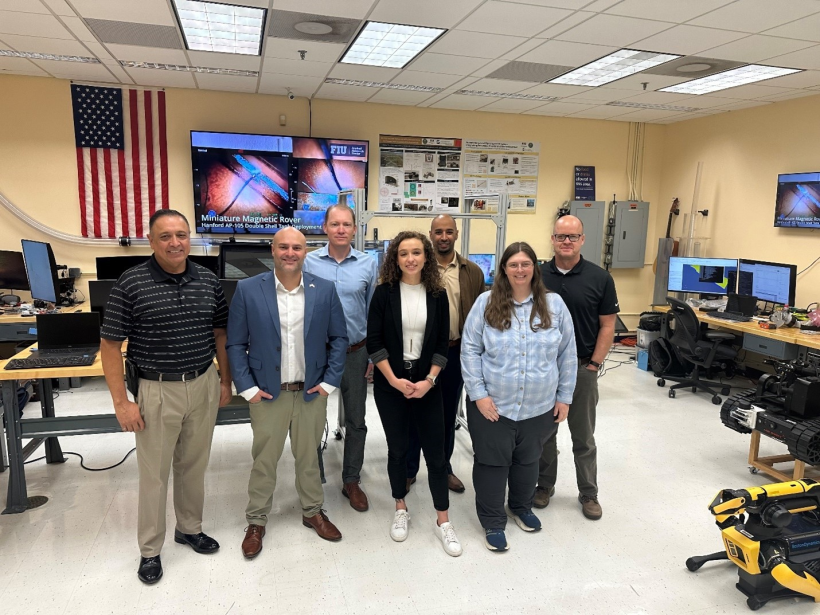
Members of the wearable robotics team gather for a photo at their recent meeting at Florida International University (FIU). They represent EM’s Technology Development Office; Sandia, Savannah River and Los Alamos national laboratories; Georgia Institute of Technology; FIU; Florida Institute for Human and Machine Cognition; and Washington River Protection Solutions.
MIAMI – Over 30 members of a team exploring the use of wearable devices to improve worker safety recently gathered at Florida International University (FIU) to discuss efforts to develop, evaluate and deploy the technology at EM cleanup sites.
FIU is among six organizations funded by EM to better understand the strains site workers face due to the physically challenging nature of their work, and to find solutions to reduce such impacts using wearable devices.
The wearable robotics program, which began in fiscal year 2020, is exploring the use of commercially available devices as well as custom solutions tailored to the unique needs of EM workers, such as compatibility with personnel protective equipment and operating in secure environments.
In a meeting with the team members, EM Office of Technology Development Program Manager Jean P. Pabón emphasized EM’s critical need to safeguard the health and safety of the workforce.
Pabón also acknowledged the team’s tremendous potential to develop innovative solutions to address EM’s challenges and needs at the field sites.

Florida Institute for Human and Machine Cognition employees exhibit a prototype for wearable robotics during the wearable robotics team’s visit to Florida International University.

From left are Leonel Lagos, Florida International University; Jean P. Pabón, EM Office of Technology Development; Jason Wheeler, Sandia National Laboratories; Gwendolyn Bryan, Florida Institute for Human and Machine Cognition; Ani Mazumdar, Georgia Institute of Technology; Beth Boardman, Los Alamos National Laboratory; and Michael Leonard, Washington River Protection Solutions. Tanner Goins with Savannah River National Laboratory is not pictured.
In addition to FIU, the team includes representatives from Sandia National Laboratories, which leads the group’s efforts, Los Alamos and Savannah River national laboratories, Georgia Institute of Technology, and Florida Institute for Human and Machine Cognition (IHMC). Three employees from Washington River Protection Solutions, an EM Office of River Protection contractor at the Hanford Site in Washington state, also attended the meeting.
Team members provided updates on their work, addressed challenges and opportunities and discussed next steps in their efforts. They also participated in tours of the FIU laboratories, where many robotic development efforts for EM sites are underway.
“The team meets every month virtually, but these in-person meetings provide a unique opportunity to dive deeper into specific areas and to physically try on devices,” said Jason Wheeler, the Sandia project lead.
The group plans to continue meeting in person one or two times a year. Previous team meetings were held at Sandia and IHMC.
-Contributors: Leonel Lagos, Jason Wheeler